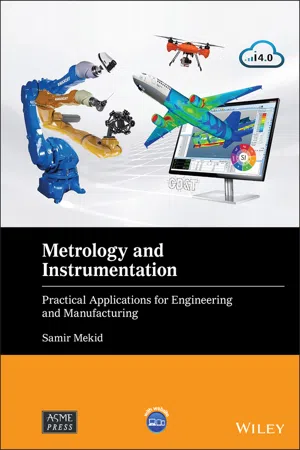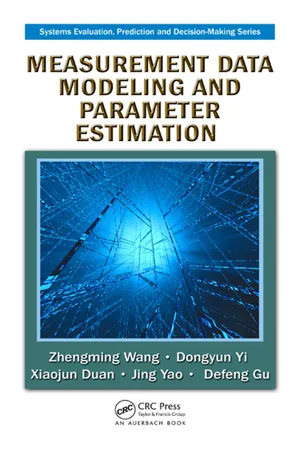Technology & Engineering
Sources of Error in Experiments
Sources of error in experiments refer to the factors that can affect the accuracy and precision of the results obtained. These errors can be classified as systematic or random errors, and can arise from various sources such as equipment limitations, human error, environmental factors, and experimental design. It is important to identify and minimize these errors to ensure reliable and valid experimental results.
Written by Perlego with AI-assistance
Related key terms
Related key terms
1 of 4
Related key terms
1 of 3
3 Key excerpts on "Sources of Error in Experiments"
- eBook - ePub
Metrology and Instrumentation
Practical Applications for Engineering and Manufacturing
- Samir Mekid(Author)
- 2021(Publication Date)
- Wiley-ASME Press Series(Publisher)
4 Errors and their Sources“If you wanna master the error, look for its source!”INTRODUCTION
Metrology's measurement error is an important subset. Manufacturing of parts or artifacts will always result in dimensional lengths that are within or outside of the specified tolerance, so it is necessary to measure the current length and determine its true measurement. The measurement process, on the other hand, is always subject to some degree of uncertainty. Measurements are not exact, and they should be reported as a range of values rather than a single value. Several examples can be found in our daily lives. If a manufactured part is given to two technicians to be dimensioned, the results will be slightly different. Furthermore, if you measure the speed of your car using the in‐car speed meter, the result may differ slightly from the police speed gun reading outside. In this case, we changed the instrument, introducing a new type of error.This chapter will define error and its various possible sources, how error propagates in measurement, errors associated with motion, error classification, and error elimination. An estimation of error or uncertainty analysis is a tool for determining the performance capability of machine tools and highlighting potential areas for performance and cost improvement. Machine designers are keenly interested in the implementation of this process. Aspects of measurement characterization used in this book will be defined later.4.1 Definition of the Error and Their Types
The error is defined as the amount by which a measured value deviates from its true value. The error is inextricably linked to the accuracy. It is attributed to three major causes: human measurement errors, the measuring method, and the instrument. The errors are divided into three categories: gross, random, and systematic.- Gross errors are a consequence of human mistakes: wrong measurement readings and recording incorrect data. Readings should be taken with care, and several readings of the same quantity should be taken and recorded.
- eBook - ePub
- Kaveh Azar(Author)
- 2020(Publication Date)
- CRC Press(Publisher)
To a large extent, the process of “cleaning up” an experiment (reducing its total error) consists of identifying and eliminating the sources of “fixed errors” and “variable but deterministic” errors. Most of the truly fixed errors are associated with the instrumentation. Most of the “variable but deterministic” errors are associated with the experimental system and the test protocol. If the source of a “variable but deterministic error” can be identified then, in general, we can do something about it. For example, the radiation error of a gas temperature sensor depends on the wall temperature — if the wall temperature changes during a test then the sensor temperature will change, even if the gas temperature remained constant. Once the cause of this variation is identified as radiation error affecting the indicated temperature, a correction equation can be written which corrects for the radiation error. The “corrected” gas temperature will not change when the wall temperature changes. Similar comments could be made about measuring the surface temperature of a component using an attached thermocouple. The apparent surface temperature may depend on the temperature of the air flowing over the thermocouple lead wires. If a correction equation is built into the experiment, this “error” is removed. 2.2.2 Sources of errors: the measurement chain To discuss where the errors come from, it is useful to have a picture of the information flow in a measuring process, from the undisturbed value to the reported value. Figure 2 shows a diagram used by Moffat (1973) to outline the steps information passes through going from the undisturbed value (the value the measured property would have had if the act of measurement had not altered it) to the corrected value which is reported. This figure provides the nomenclature for discussing three different sources of error in a measurement: system disturbances, system/sensor interactions, and instrumentation errors - Zhengming Wang, Dongyun Yi, Xiaojun Duan, Jing Yao, Defeng Gu(Authors)
- 2016(Publication Date)
- CRC Press(Publisher)
This book focuses mainly on the mathematical processing of measurement data. Thus, the analysis, estimation, and correction of measurement error are emphasized in the book.Measurement error is the difference between the observed value and the true value. Let u be the true value, x be the observed value, and δ be the measurement error. Then,The true value exists objectively but is unknown or cannot be determined in the process of measurement. Another terminology in measurement is discrepancy. Discrepancy is the difference between two measurements. Discrepancy is always known but it cannot show the accuracy of measurement.δ = x - μorμ = x - δ.1.2.2 Source of Errors
Generally, errors come from multiple sources such as measurement methods, measurement devices, environmental conditions, human beings, etc.- Methodological error: Measurement methods and principles cause measurement errors. For example, the volume of a steel ball is V = ( 1 / 6 ) πwhere d is the diameter of the ball. Sinced 3( 1 / 6 ) πcan only be approximated, the difference between the true and the approximate values of the volume is a methodological error.
- Equipment error: This kind of error contains benchmark error and measuring equipment error. A benchmark error is an error in comparing standard physical quantities such as the error of balance weight. Measuring equipment error is caused by the equipment production, installation, accessories, and other factors.
- Environmental error: This kind of error is caused by environmental factors such as temperature, humidity, air pressure, vibration, magnetic field, etc. For example, the refraction of electric wave due to the heterogeneity of air causes the measurement error in tracking the orbit of a spacecraft.
- Human error: Errors due to surveyor’s circadian senses, work attitudes, work habits, proficiency, and so on.
There are many sources of measurement error. In the process of analyzing measurement data, we should focus on the main sources of error and analyze their characteristics to ensure the relevance and accuracy of mathematical models.
Index pages curate the most relevant extracts from our library of academic textbooks. They’ve been created using an in-house natural language model (NLM), each adding context and meaning to key research topics.
Explore more topic indexes
Explore more topic indexes
1 of 6
Explore more topic indexes
1 of 4


